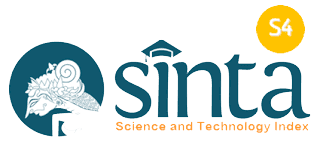Analisys of The Effectiveness of The Utilization of Electronic Government On State-Owned Enterprises
(1) Public Administration, Universitas Pepabri Makassar
(*) Corresponding Author
DOI: https://doi.org/10.26858/pdr.v4i2.19946
Abstract
The use of electronic government (e-gov) of face and finger access control has been implemented at PT. PLN Tello Sector Makassar City and is expected to be able to streamline employee performance. The purpose of this study, is to analyze the effectiveness of the use of face and finger access control at PT. PLN Tello Sector Makassar City. This research method uses quantitative research types with quantitative descriptive research types. Data collection techniques using questionnaires in the form of a checklist and using descriptive analysis techniques. The results showed that the effectiveness of the use of face and finger access control at PT. PLN Tello Sector Makassar City is in quite good category, based on the analysis of target achievement indicators, adaptability, job satisfaction, and responsibility.
Keywords
Full Text:
PDFReferences
Akman, I., Yazici, A., Mishra, A., & Arifoglu, A. (2005). E-Government: A global view and an empirical evaluation of some attributes of citizens. Government Information Quarterly, 22(2), 239–257.
Bardach, E., & Patashnik, E. M. (2019). A practical guide for policy analysis: The eightfold path to more effective problem solving. CQ press.
Bazen, A. M., & Gerez, S. H. (2002). Achievements and challenges in fingerprint recognition. In Biometric Solutions (pp. 23–57). Springer.
Endang, P., & Irma, P. S. (2014). The affect of work environment, job satisfaction, organization commitment on OCB of internal auditors. International Journal of Business, Economics and Law, 5(2), 10–18.
Farida, U. (2017). Analysis of Empowerment Program that was Implemented in Mamuju Regency East Sulawesi Indonesia. 149(Icest), 19–21.
Hadiana, R. N. (2019). The influence of transformational leadhership and commitment organization implications for performance employee State Civil Apparatus (Asn Bandung Indonesian). UNIVERSITAS PASUNDAN.
Hakim, A. (2012). Dinamika Manajemen Sumber Daya Manusia Dalam Organisasi. Efpres Digimedia.
Hülsheger, U. R., Alberts, H. J. E. M., Feinholdt, A., & Lang, J. W. B. (2013). Benefits of mindfulness at work: the role of mindfulness in emotion regulation, emotional exhaustion, and job satisfaction. Journal of Applied Psychology, 98(2), 310.
Indrajit, R. E. (2016). Electronic Government: Konsep Pelayanan Publik Berbasis Internet dan Teknologi Informasi. Aptikom.
Ismail, A., Sulur, A. H., Akib, H., & Salam, R. (2016). Snapshot of Society Social-Economic Welfare based on Human Development Index in Polewali Mandar Regency, Indonesia. International Conference on Public Organization VI (ICONPO VI), 847–858.
Jain, A. K., Nandakumar, K., & Ross, A. (2016). 50 years of biometric research: Accomplishments, challenges, and opportunities. Pattern Recognition Letters, 79, 80–105.
Lee, L. T., & Sukoco, B. M. (2007). The effects of entrepreneurial orientation and knowledge management capability on organizational effectiveness in Taiwan: the moderating role of social capital. International Journal of Management, 24(3), 549.
Lin, H. (2007). Knowledge sharing and firm innovation capability: an empirical study. International Journal of Manpower.
M. Konisky David, T. C. B. (2001). Innovations in public participation and environmental decision making: examples from the Great Lakes region. Society & Natural Resources, 14(9), 815–826.
Maeyasari. (2012). Pengaruh efektivitas penerapan Absensi Finger Print Terhadap Disiplin Pegawai Negeri Sipil di Sekretariat Daerah.
Mohd, A., Ortjohann, E., Schmelter, A., Hamsic, N., & Morton, D. (2008). Challenges in integrating distributed energy storage systems into future smart grid. 2008 IEEE International Symposium on Industrial Electronics, 1627–1632.
Priyono, M. (2016). Manajemen Sumber Daya Manusia. Zifatama Publisher.
Proctor, C. R. (2014). Effective organizational communication affects employee attitude, happiness, and job satisfaction. Southern Utah University. Department of Communication. 2014.
Sahlin-Andersson, K. (2011). Imitating by editing success: The construction of organizational fields. In Translating organizational change (pp. 69–92). de Gruyter.
Siagian. (2015). Peranan Staf dan Manajemen. Gunung Agung.
Siegel, D. S., Waldman, D. A., Atwater, L. E., & Link, A. N. (2003). Commercial knowledge transfers from universities to firms: improving the effectiveness of university–industry collaboration. The Journal of High Technology Management Research, 14(1), 111–133.
Sunarsi, D. (2019). Analisis Pengaruh Lingkungan Kerja dan Budaya Organisasi Terhadap Kinerja Serta Implikasinya pada Kepuasan Kerja Guru Sekolah Dasar Di Wilayah Kabupaten Bogor-Jawa Barat.
Sunarsi, D., & Erlangga, A. (2020). The Effect of Leadership Style and Work Environment on the Performance of Stationary Pump Operators in the Water Resources Office of West Jakarta City Administration. International Journal of Advances in Social and Economics, 2(3).
Tangkilisan Nogi Hessel. (2015). Manajemen Publik. Gramedia Widiasarana.
Williams, C. (2007). Research methods. Journal of Business & Economics Research (JBER), 5(3).
Zainal, H., Parinsi, W. K., Hasan, M., Said, F., & Akib, H. (2018). The influence of strategic assets and market orientation to the performance of family business in Makassar City, Indonesia. Academy of Strategic Management Journal, 17(6).
Article Metrics
Abstract view : 201 times | PDF view : 26 timesRefbacks
- There are currently no refbacks.
Copyright (c) 2021 Andi Rahmatiah


































